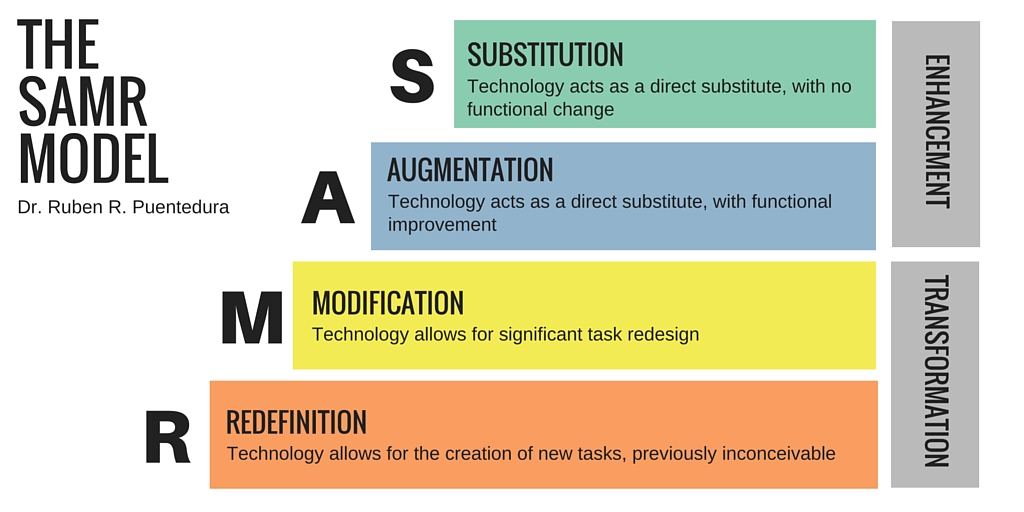by Joseph Kenney and Rosemary Pearce
Our team recently attended a presentation on using the SAMR model for transforming assessment by our colleague Rachel Challen (Learning, Teaching and Staff Development Manager for the School of Arts and Humanities at NTU). We spoke to her afterwards to share some of her ideas on how we should be thinking about transforming assessment using digital tools, including what the key considerations and benefits are.
The SAMR Model – an example

The SAMR model, which educators can use when digitally transforming curriculum and assessment, was developed by Dr R. Puentedura. Rachel Challen gave us the following example of how it might be applied to an existing reflective essay assessment, which is handwritten and submitted to student registry:
Substitution (enhance): A reflective essay, written with Microsoft Word, printed out and submitted to student registry.
Augmentation (enhance): A reflective essay, written with Microsoft Word, submitted through the Virtual Learning Environment (VLE).
Modification (transform): A reflective essay, written with an ePortfolio, submitted through PebblePad, with regular iterative entries – moving from product to process.
Redefinition (transform): A reflective essay, using ePortfolio, submitted through PebblePad, with regular iterative entries – moving from product to process, making full use of audio and video reflective entries and feedback.
The slides of Rachel’s SAMR Model presentation are available on the National Teaching Repository.
Pedagogy and technology: a chicken and egg situation
Joseph: In your presentation you compare technology and pedagogy to the chicken and egg situation. So which should come first, in your opinion?
Rachel: I don’t feel this can ever be properly answered because the situation changes. If you’d asked me this in 2009 I probably would have said the technology first, because that’s where I was in my thinking and my development and we wanted to get people on [the Virtual Learning Environment]. But if you’d asked me from 2010 to 2020, I would have very firmly have been in the pedagogy first camp. If I had to choose one or the other now, I would still do that.
But the pandemic has shown me that there are situations where you have to deal with the technology first. In those first months of the pandemic, we had to say “this is how you get your students onto MS Teams.” I think 90% of the time I’m pedagogy first and then 10%, depending on circumstance, technology first, and to be 100% on either one is detrimental because it means you’re just driving towards one thing without taking into account the scenery, I guess.
Aiming for transformation, not just enhancement
Joseph: What are the potential benefits of aiming for the transformational level of the SAMR model as opposed to just aiming to enhance assessment with technology?
Rachel: You can’t transform a traditional assessment into a digital assessment without putting the skills development in place. If you are trying to enhance assessment with technology, you have to enhance your curriculum with technology. And I think that the SAMR model is key to be able to do that.
Joseph: Do you suggest starting with substitution and augmentation and then moving on to modification and redefinition?
Rachel: It depends on where the tutor is and where the students are in relation to their skills, that understanding and the purpose of the assessment. Wherever you are with your curriculum design has also got to be where you are with your assessment, you have got to be able to support the students step-by-step to get to where you want them to go. If you have a curriculum design which is just a substitution, but your assessment is redefinition, then your students are going to struggle. And then similarly, if your curriculum design is redefinition and your assessment design is substitution, then you are not stretching the students enough.
Key considerations for educators
Rosemary: What do you think are the key considerations for educators who are thinking of beginning a process of digitally transforming their existing assessments?
Rachel: I don’t see it as often now, but sometimes there could be a lack of purpose for adding a digital assessment, without thinking of key questions around purpose and curriculum fit.
For instance, what is the purpose of having students do that digital assessment with that digital tool? Is it because they are on an IT or Media course, and they need to know how to use that tool? Or is it because you are trying to be inclusive and give different outlets for the assessment and, actually, the outlet doesn’t matter, but the content does?
So, when tutors have decided what they’re going to be grading and what the appropriateness is, then they can start transforming because their purpose is clear.
For more on this topic, see Rachel’s article for Times Higher Education Campus, Inclusive pedagogy: using multimedia as a tool to enhance and transform assessment.
